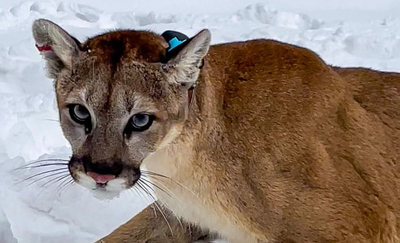
SALT LAKE CITY (ABC4) -- In May of 2022, a female cougar dubbed F66 left her home in the Wasatch mountains and undertook a 1,000-mile journey through Wyoming, eastern Utah and most of Colorado.
It was the longest trek ever recorded in a GPS-collared cougar, according to Morgan Hinton, a wildlife biologist with the Utah Division of Wildlife Resources, who wrote about F66’s journey in a blog post published this week.
“She crossed I-80 twice, which was incredible, as well as some other major highways in Utah and Colorado,” Hinton said, adding that F66 also swam across Flaming Gorge Reservoir in southern Wyoming.
While she was killed by another cougar in Colorado, her incredible five-month journey is just one narrative example of how GPS collars are allowing Utah researchers to get more precise data on the behavior of the elusive cats in all manner of categories, from movement to prey.
“We are only now realizing these things are happening because we have the ability to track these animals on a really fine scale,” Hinton told ABC4 on Wednesday.
Collared Cougars in Utah
Darren DeBloois, the game mammals coordinator with the Utah Division of Wildlife Resources, said that Utah has used GPS collars on cougars over the last six years.
These efforts have been part of wildlife research studies with BYU and Utah State University. Between the two study groups, more than 60 cougars have been collared across the state.
“At the moment, we have 20 mountain lions with collars that are active and on the air,” DeBloois said, noting that battery life on the collars lasts a couple of years.
While the cougars give the collars a beating out in the mountain wilderness, they can’t remove them, DeBloois said. The devices ping the location of the cats every two hours, anywhere on earth.
That’s an improvement over the old radio collars, which lost signal if a cougar ran out of range. Had F66 been wearing one of those radio collars, her story would have been lost to the wild.
Collaring a Cougar
Wildlife researchers are familiar with collaring animals. For ungulates (mammals with hooves) like deer, elk and pronghorn, a helicopter crew can capture and collar dozens of animals in a single day. That’s not the case for cougars.
To find the cats, trained hounds and houndsmen are needed. The dogs track the cougars to a tree, the researchers tranquilize the cat, then lower them down to the ground and collar them.
“It took us almost two years to collar 37 [cougars], and that was with some of the houndsmen and researchers committing a lot of time to it. So, they are very time-intensive to capture,” Hinton said.
She said that tracking the cougars in Utah brought her to beautiful places in the mountains, where the cats tend to live. It wasn’t lost on her that she was getting facetime with animals that people would be lucky to see once in their lifetime.
“To be up close and personal with them, look them in the eye when they are in a tree and feel them when they are on the ground, to be that close to mountain lions is really cool and a lot of fun,” Hinton said. “It kept me in really good shape, too.”
What we’re learning
The two studies on the collared cougars in Utah are focused on different things. One study, which just wrapped up, was focused on cub survival.
According to DeBloois, the researchers followed female cougars to their dens and put collars on the mother and cubs. The little cub collars communicate through the mother’s collar, allowing researchers to determine when the little ones aren’t with their mom.
“If they stop being with mom, we could go in and look and see what’s going on,” DeBloois said.
The other study, which remains ongoing, is focused on what cougars are eating or scavenging. (This is the study that Hinton is working on.)
While the cougars are mostly hunting mule deer, they’ll also make some surprising prey choices. For instance, DeBloois said one collared cougar migrated off the Wasatch Front to Porcupine Reservoir, where it feasted on porcupines for the better part of a summer.
The collars are also allowing researchers to study how cougars move through the landscapes and interact with other animals, such as bears. Currently, the research suggests while bears will steal a cougar kill or two, the cats don't avoid bears when they are in their territory.
The DWR estimates via cougar hunting kills that there are about 4,000 cougars across Utah.